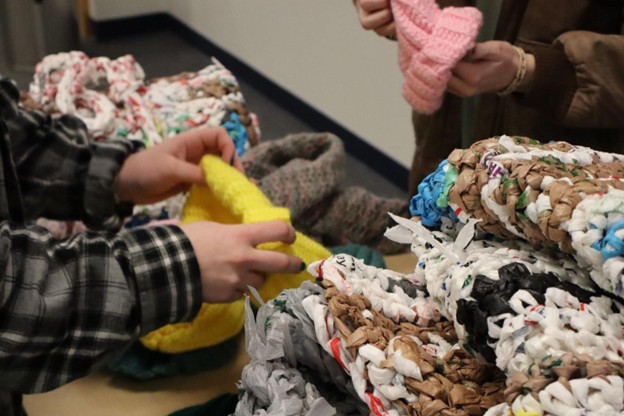Loyola students may be wondering why members of the Student Government Association (SGA) are handing out flyers with pitchers of beer on them. After all, they are not to condone the consumption of alcohol—they are to represent the student body, and they are to do it in a positive way.
Since Friday, September 20, SGA members have set up a table on the academic quadrangle asking students to sign a petition for the establishment of a Responsible Action Protocol (RAP). The RAP is a policy that would provide students with amnesty from judicial sanctions if they call emergency services for another individual suffering from alcohol poisoning, drug overdose or in any other emergency situation—even if the students have been drinking or abusing drugs themselves.
SGA started working on the RAP proposal in October 2011 when they created a task force to discuss why students refrained from calling emergency services. They discovered that many students could not recognize the signs of alcohol poisoning and also feared disciplinary action would be taken against them if they called for help.
Several other universities—including other Jesuit ones such as Boston College, the College of the Holy Cross, Fairfield University, Fordham University, Georgetown University, Gonzaga University, Loyola Marymount University and Santa Clara University—have adopted similar policies, all of which grant disciplinary immunity to intoxicated students seeking medical attention. Yet, Loyola administrators still do not want a new policy.
“Student Life says 70 percent of students call [for help]…why don’t we have 100?” said Louis Margules, 2014, who is the director of judicial affairs for SGA. “This is the reality. If this is something that affects us, why not talk about it?”
Margules stated that Loyola as a whole tends to shy away from talking about the existing drinking culture on campus, and that the alcohol discussion “ruffles feathers” for many people, regardless of their views on alcohol consumption. Many people do not want Loyola to be represented as a drinking school, and choose to avoid the discussion altogether.
“People are still going to drink to that amount [of severe intoxication],” said Margules. “If there’s something in place for people to call and potentially save lives, why aren’t we having this discussion? This is about students’ wellness and safety…that’s the point we want to drive home.”
Jessica Peters, 2015, said, “I would still call because, honestly, you’re saving your friends life…the bottom line is that is more important than getting in trouble. Ultimately it’s about taking care of people. People are going to get in trouble with or without the education.” She then added, “I think there is education. There is for freshmen, and all the athletes do repeated alcohol education. Regardless of different situations, people are still going to drink.”
“It’s not a get-out-of-jail free [card]; it’s not changing the no-tolerance [policy],” said Margules. Instead, he ensured, it allows students to get help for their friends without having second thoughts or worrying about the potential disciplinary sanctions of underage or excessive drinking, which are outlined in the Student Code of Conduct.
“Let’s have a larger conversation about the drinking culture,” said Margules, whose job is to initiate just that.
During the summer, SGA’s Director of Student Affairs, Chris Singlemann, 2016, put together the RAP proposal, which was finalized on July 24. Margules’ job is to oversee the proposal and work with SGA to advocate for Loyola’s student body. Additionally, SGA is working to encourage student and administrative discussion on the alcohol issue on campus.
“We’re not a dry campus, so why not have the discussion?” said Brendan Fulmer, 2014, SGA’s student body president, who has been working with administrators on the RAP proposal. “We’re adults. We’re not high school students that you have to cover our ears. We need to talk about it like adults.”
“Since [drinking] is such a big part of the culture, we have to talk about it… I would say that students haven’t reached out because they don’t want to talk about it; it’s uncomfortable because it’s illegal, and it’s hard to do,” said Peters. “If both parties sit down, each has to give a little.”
Peters explained that she felt students needed to agree to limit the amount and frequency of drinking activities to enter an adult conversation with administrators about the drinking culture, but that they were unlikely to do so because many want the discussion to be unregulated by administrators. She also added that the administration needs to accept the fact that students will engage in such behavior and be open to an honest dialogue with students. Peters noted the lack of acknowledgement by administrators of the drinking culture on campus, but thinks it is important for them to do so to help administrators and students collaborate effectively.
“We are not people who want to pretend drinking is not happening,” said Dr. Sheilah Horton, the vice president for Student Development and dean of students. “In fact, we are well aware it is happening… We took surveys of incoming freshmen and we’re learning that students are coming here already having blackouts before coming to college. It lets us know that we’re dealing with a community where many have come already drinking a fair amount.”
Additionally, Dr. Horton said that administrators are willing to and want to have an honest dialogue with students about drinking—one that is not only sensational but also educational, she stipulated.
“Father Linnane is very attuned to the alcohol conversation…both nationally and also at Loyola,” said Horton who mentioned that he is also a member of the Maryland Collaborative to Reduce College Drinking and Related Problems.
However, Horton explained that Student Life uses their own discretion when disciplining students. According to Christina Spearman, the director of Student Life, the sanctions outlined in the Student Code of Conduct are guidelines.
“When we look at those sanctions, we see them as standard sanctions,” said Spearman. “When we say standard sanctions, it’s standard. We never said it was mandatory.”
Additionally, Spearman said that students who call for help in cases of medical emergencies involving illegal substances usually do not receive disciplinary consequences, and often have a positive experience in dealing with Student Life because, many times, they radically altered their night to help a friend.
“We’re really looking at consequences when someone might need them,” said Spearman who explained that Student Life handles alcohol and drug violations on a case-by-case basis.
“Students shouldn’t be afraid to call. The predominant [disciplinary] approach is education,” said Horton, who pointed out that students found participating in prohibited activities involving alcohol and drugs are mandated to go to the Alcohol and Drug Education and Support Services (ADESS).
“The sanction that is nonnegotiable is education,” said Spearman, who explained that fines and reprimands may be waived but the educational aspect—going to ADESS—is required for students hospitalized as a result of alcohol or drug abuse.
Public Safety Director, Timothy Fox, also said that he felt that a policy may not be necessary because he felt potential punishments should not deter a student from calling help for their friends. He did acknowledge uncertainty over whether more students would call if the RAP became policy. However, Fox pointed out that most of the students who do call do not face sanctions.
“In the past, I don’t think they’ve been in significant trouble… They could get in trouble, but that’s not a good assumption…there’s no empirical evidence,” said Fox.
“RAP is just something in writing…that we want in the community standards,” said Margules. “If something already exists, then we want to know about that.” He said something written would give students a “peace of mind,” and allow them to call immediately instead of hesitating out of fear for punishment.
Horton also said the University needs to uphold the law and respect that the drinking age is 21. She felt that SGA’s RAP was a change in policy, and said she felt that education was more important than policy change. Horton said she wanted to see SGA present a plan on educating students on the signs and symptoms of alcohol poisoning and other medical emergencies.
“Alcohol EDU ran some numbers… They did learn that students weren’t sure about the signs and symptoms,” said Horton who told SGA to start an educational campaign, but said she received the RAP instead.
Additionally, Horton said student leaders such as SGA and others need to stand up against drinking irresponsibly.
“I call upon all our student leaders against allowing friends to get to that level of intoxication,” said Horton. “Student leaders need to lead students to act better first, instead of this initiative.”
Horton also spoke briefly about the new alcohol education program that first-year students are required to take called “Think About It.” This new program is more designed to teach what she called “bystander intervention,” which is students stepping in and stopping their friends from drinking too much alcohol and making irresponsible decisions. Such intervention, she said, could prevent hospitalizations and sexual assault, among other problems brought on by excessive drinking.
Until SGA focuses more on educating students, she said she was not ready to pass the RAP. Additionally, she said she felt the protocol was unnecessary at Loyola since her numbers showed most students called for emergency personnel in cases where their friends needed serious medical attention anyway, without fear of the possible disciplinary consequences, and that Student Life handled such cases on an individual basis.
“It’s been remarkable the number of students that call,” said Horton. “Students do call for help at Loyola…it’s their friends. It’s rare that the police pull a kid out of the bushes at Loyola.”
According to Spearman in the Office of Student Life, the average hospital transports per school year ranges from 14 to 20, and 70 percent of those students are transported because their peers called emergency personnel. This year alone, there have been eight hospitalizations, six of which were called for by students. According to Fox, there have been 18 alcohol-related incidents on campus and three controlled dangerous substance (CDS) incidents during the first four weeks of the semester.
However, Margules emphasized the educational aspect of the RAP, which he said would help students recognize the signs of alcohol poisoning and tell them when emergency services are needed. He made mention of Campus Police’s idea to issue some kind of informational item, such as a magnet or card, that would educate students on the symptoms of alcohol poisoning. He also cited examples of other colleges putting permanent plaques in bathrooms with the signs and emergency contact numbers as more effective. “It needs to be a comprehensive solution,” said Margules.
By introducing a campus-wide conversation about drinking, he said SGA could educate students on the symptoms of alcohol poisoning, and when professional medical help is necessary. Margules said that SGA intends to inform students by holding forums, however such forums have yet to be announced.
“I’m ambivalent about [RAP]. The thing that we feel very strongly about is the education piece,” said Cindy Parcover, the Assistant Director for ADESS. Parcover explained that many students are referred to ADESS as a result of the disciplinary sanctions.
“I don’t call that getting into trouble,” said Parcover, who also expressed a concern for the students who would receive judicial amnesty as a result of RAP, saying that they would not receive educational counseling that would teach them how to act responsibly.
“I’m worried about the students—that’s traumatic for the students that call. It’s hard on a relationship. It takes good friends to go through all that and call for a friend,” said Parcover. “Students who go through that need counseling.”
However, Parcover pointed out that a health and wellness survey facilitated by ADESS asked if students would call for help in cases of an alcohol-related emergency, and what those students’ concerns would be if they found themselves in such a position. The survey revealed that most students would call for help, no matter what. It also showed that 3.4 percent of students (of 1,346 students surveyed) had already sought some kind of medical help for friends, or even themselves in cases of alcohol-related emergencies. However, there was no data on which students received fines or other reprimands.
In addition to that survey, Parcover spoke about another survey taken of Loyola students, which revealed disconnect between students’ beliefs and perceptions about the beliefs of their peers.
“My take on the student body is that there are abstainers; there aren’t a lot of abstainers—it’s about 10 percent…but the majority of students drink really responsibly. They don’t experience negative consequences, they’re not blacking out, they’re not getting alcohol poisoning, they’re not getting into fights and having injuries, they’re not experiencing unwanted sexual situations or regretted actions. They are drinking with relatively low frequencies,” said Parcover. “Alcohol is a piece of their social life, but it’s not their whole social life. There is a minority where it is their social life…but for the most part, students take really good care of themselves.”
“I also know that it’s really hard to not drink…[students] have a really hard time feeling that their peers support them… I hear the phrase with relative frequency: ‘I can’t ask my friends to not go out–that’s just too much to ask,’” said Parcover. She explained a study done by ADESS which asked students how they felt about drinking, then how they thought their peers felt about drinking. The data showed that students overestimate how their peers feel about excessive drinking, and underestimate their peers’ tolerance of abstaining from drinking.
“For some reason people think people are OK with blacking out…but data tells us that people are not doing that,” said Parcover. “I think it’s because people don’t talk about it…there is a loud minority, and whether we like it or not, it dictates our culture.”
Peters said, “I think that it’s part of that social acceptance piece…because so many people are going out you feel like your peers are judging you; abstaining isn’t seen as a cool thing, but the reality is people don’t care. I think that’s an example, the way people think people perceive you. A lot of people engage in the drinking culture because they want to be accepted…they think that’s the acceptable thing to do here, and that’s not cool. You shouldn’t have to change your goals just to fit in.”
Parcover said she and ADESS were open to having the alcohol conversation with students, however she said that most students enter the doors of ADESS as a result of receiving disciplinary sanctions, and rarely of their own volition.
“I really respect my colleagues that are more on the judicial side that are interested in meeting students where they are at. It may not feel like that to students,” said Parcover. “Students don’t need to wait until they get in trouble or things get out of control. The judicial piece does get students into our door.”
Parcover also expressed concern over the necessity of the RAP, saying that students should look for a better way to address excessive alcohol use and the resulting dangers than a policy, however she said that perhaps something needs to be officially put in place if students really are afraid of being disciplined for calling for help.
“In my experience, the student that does call doesn’t have a negative experience,” said Parcover.
Concerning SGA and administration’s perceived differences, Parcover said, “It’s important to recognize that the goal is exactly the same. I think that frequently…based on my experience, there’s an ‘us and them;’ there’s the adults, and there’s us. At Loyola, that’s not the case at all, there’s a sense of a common goal…a common concern for students.”
“I don’t think students should be afraid to talk; they should be open to different thoughts and opinions… The judicial piece will never go away,” said Parcover, who added that she felt students and administrators need to meet in the middle and understand their common goals, rather than seeing each other as separate parties to an issue.
“It’s not black and white,” said Parcover. “We all need to find a space that is not polarized.”
SGA members say they plan to meet again with Dr. Horton this week to work more on their proposal.
“We are in the beginning…we’re in the introduction stage,” said Fulmer.
“In the conclusion, we hope to have that administrative support,” said Margules.










































































































